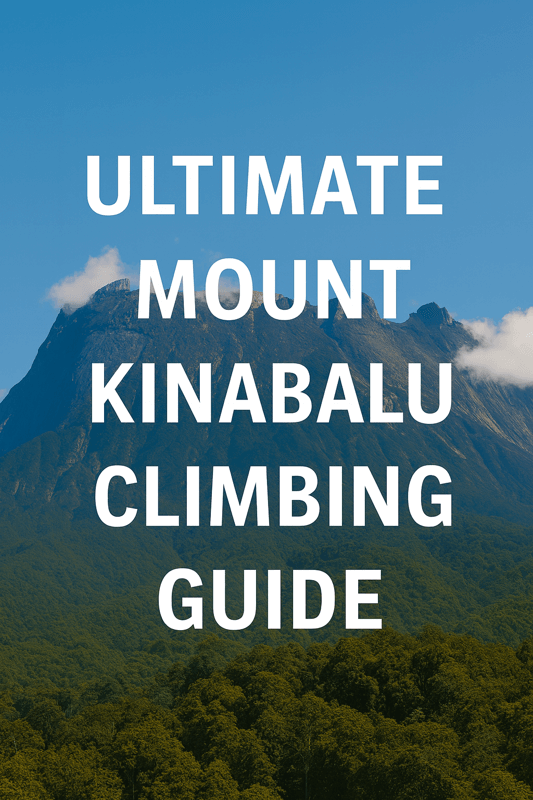Mount Kinabalu climbing guide for tourists – Mount Kinabalu, rising 4,095 meters above sea level in Sabah, Malaysia, is Southeast Asia’s highest peak (outside the Himalayas) and a UNESCO World Heritage Site. Climbing it is a bucket-list adventure for many travelers, but it requires preparation, permits, and the right timing.
Whether you’re a first-time hiker or a seasoned trekker, this Mount Kinabalu climbing guide for tourists will walk you through permits, routes, the best time to climb, and essential tips for a safe and unforgettable experience.
1. Understanding Mount Kinabalu
- 📍 Location: Kinabalu Park, Sabah, Malaysian Borneo — about 90 km (2-hour drive) from Kota Kinabalu, the state capital. The park is easily accessible by bus, shared taxi, or private transfer.
- ⛰ Height: 4,095 m (13,435 ft) — making it the highest mountain in Malaysia and one of the tallest peaks in Southeast Asia outside the Himalayas.
- 🌏 Status: UNESCO World Heritage Site (since 2000) — recognized for its incredible biodiversity, with over 5,000 plant species, rare orchids, and unique animals such as the Kinabalu giant red leech and Kinabalu giant earthworm.
- 💡 Fun Fact: The name “Kinabalu” is believed to come from the Kadazan-Dusun words Aki Nabalu, meaning “Revered Place of the Dead.”
2. Do You Need a Permit?
Yes. All climbers must obtain a climbing permit issued by Sabah Parks.
- Yes. All climbers must obtain a climbing permit issued by Sabah Parks. Permits are strictly limited to around 150 climbers per day, so it’s essential to secure yours well in advance — ideally 3 to 6 months before your climb, and up to 9 months ahead if you’re aiming for peak seasons (February–April and September–December).
- You are also required to climb with a licensed mountain guide, which is mandatory for safety and included in most booking packages.
Permit Fees (approximate):
| Category | Fee (MYR) |
|---|---|
| Malaysian adult | RM 50 |
| Non-Malaysian adult | RM 200 |
| Malaysian child (below 18) | RM 30 |
| Non-Malaysian child | RM 80 |
💡 Booking Tip: You can arrange permits through Sabah Parks or approved tour operators.
3. Popular Routes to the Summit
Mount Kinabalu has two main climbing routes:
A. Timpohon Gate Route (Most Popular)
- Distance: ~8.72 km to the summit
- Suitable for beginners with good fitness
- Starts at Timpohon Gate (1,866 m)
- Requires an overnight stay at Laban Rata or nearby huts
B. Mesilau Trail (More Scenic)
- Distance: ~8 km but steeper
- More challenging, with lush rainforest views
- Currently reopened for certain guided tours after being damaged by the 2015 earthquake
💡 Most climbers take Timpohon up and down for efficiency, especially first-timers.
4. Best Time to Climb Mount Kinabalu
Sabah’s weather is tropical but varies in the highlands.
Best Months:
- February – April: Dry, clear skies, less rainfall
- September – early December: Cooler weather, fewer crowds
Avoid:
- November – January: Monsoon season (slippery trails, poor visibility)
- May – August: Still possible, but afternoon rain is common
Turtle Season Bonus: Combine your trip with a visit to Selingan Turtle Island (May–September) for turtle nesting experiences.
5. Itinerary Options
2D1N Standard Climb (Most Popular)
- Day 1: Register at Kinabalu Park HQ → Hike to Laban Rata (3272 m) → Rest overnight
- Day 2: Early morning summit attempt → Return to Timpohon Gate → Receive certificate
1-Day Climb (Not recommended for beginners)
- Very challenging, less time for acclimatization
- Only available for climbers with proven high-altitude experience
6. Costs Involved
Climbing Mount Kinabalu is a bucket-list adventure, but it’s not cheap. Expect to budget RM 1,000–1,500 per person for the standard 2D1N climb, which usually includes:
- Climbing permit & licensed guide fee
- Accommodation at Laban Rata or Pendant Hut
- Meals during the climb
- Transportation to and from Kota Kinabalu
💡 Alternative Ways to Experience the Summit:
If you want the Mount Kinabalu high-altitude experience without committing to the full multi-day climb, you can try the Via Ferrata — the world’s highest, starting at 3,776 m — or take a helicopter tour from Kota Kinabalu for breathtaking aerial views. Both options let you enjoy the mountain’s beauty without the same level of physical endurance needed for the full hike.
| Experience Type | Estimated Cost (per person) | Duration | Physical Effort | Includes Summit? | Highlights |
|---|---|---|---|---|---|
| Full Climb (2D1N) | RM 1,000–1,500 | 2 days, 1 night | High | Yes | Sunrise from Low’s Peak, biodiversity, UNESCO trails |
| Via Ferrata | RM 1,500–2,000 (with climb package) | 2 days, 1 night | High (with added technical sections) | Yes | Cliffside walk, ladders, suspension bridges, highest via ferrata in the world |
| Helicopter Tour | RM 2,500–4,000 | ~30–45 mins | Low | No (flies around summit) | Aerial photography, panoramic views of Kinabalu & surrounding landscapes |
7. Physical Preparation
Climbing Mount Kinabalu is challenging, especially due to its steep inclines and high altitude. Proper preparation will greatly improve your chances of reaching the summit comfortably and safely.
1. Build Your Fitness Early
- Start training 8–12 weeks before your climb.
- Focus on leg strength and endurance with activities like hiking on uneven terrain, stair climbing (with a weighted backpack if possible), and long-distance walking.
- Include cardio workouts (running, cycling, swimming) 3–4 times per week to improve stamina.
- Add core and balance exercises (planks, squats, lunges) to handle the uneven paths and rocky summit terrain.
2. Practice with Real Conditions
- If possible, hike at higher elevations in your home country to get used to thinner air.
- Break in your trekking shoes ahead of time to avoid blisters.
- Practice carrying a small daypack with 3–5 kg to simulate the climb.
3. Understand Altitude Sickness
- Learn the symptoms: headache, dizziness, nausea, and shortness of breath.
- Ascend slowly and take breaks — rushing increases the risk of altitude-related issues.
- If symptoms get worse, inform your guide immediately.
4. Hydration & Nutrition
- Drink water regularly before and during the climb (2–3 liters per day).
- Carry electrolyte packets or sports drinks to replace salts lost through sweating.
- Eat a balanced diet with enough carbs and protein in the weeks before your trip to fuel your body.
5. Rest & Recovery Before the Climb
- Get 7–8 hours of sleep nightly for at least a week before your climb.
- Avoid intense workouts 2–3 days before to let your body recover.
- Arrive in Sabah at least one day early to adjust to the climate and avoid travel fatigue.
8. Packing Essentials
- Warm clothing (temperatures can drop to 0°C)
- Waterproof jacket
- Headlamp for early summit attempt
- Sturdy trekking shoes
- Gloves and beanie
- Energy snacks & electrolyte drinks
9. Where to Stay Before & After
- Kota Kinabalu City: Great for budget stays, shopping, and food
- Near Kinabalu Park: Sutera Sanctuary Lodges, Kundasang homestays
Final Tips
- Book early (3–6 months ahead for peak seasons)
- Don’t rush — enjoy the scenery and biodiversity
- Respect park rules and your guide’s instructions
- Take time to acclimatize — safety first, summit second




